AMD’s Radeon HD 5850: The Other Shoe Drops
by Ryan Smith on September 30, 2009 12:00 AM EST- Posted in
- GPUs
Power, Temperature, & Noise
With Cypress pared down some for the 5850, the power/temperature/noise situation takes on a different look. The 5870 ended up being hot, noisy, and more power-hungry than any other single-GPU setup under load. Let’s see if the 5850 can avoid that.
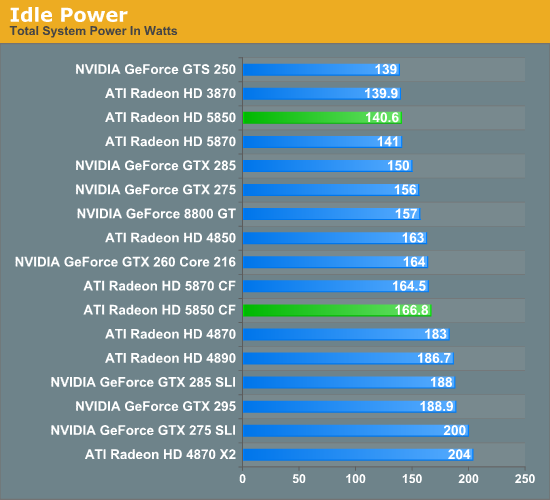
Looking at idle power, the results are the same as the 5870. This is to be expected as both are capable of reaching the same low idle power state. Crossfire results are similar, although the 5850 CF nudges itself higher than the 5870 CF on our charts; but this is within experimental variance.
As was the case with the 5870, the 5850 is among the lowest idling cards we have seen. It’s at the very bottom, only the Radeon HD 3870 and the GeForce GTS 250 can beat it, and even then just by a watt and a half.
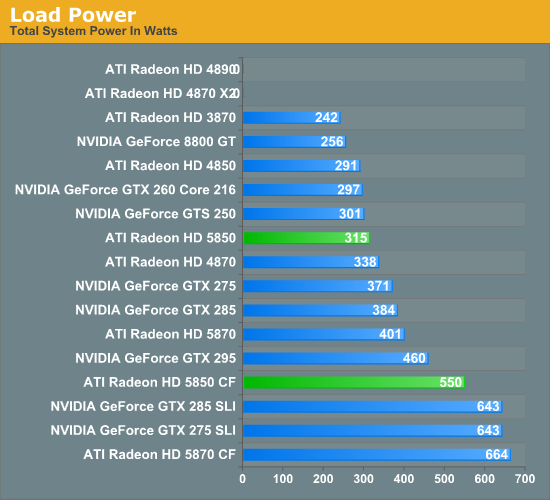
Load power on the other hand gives us a surprising difference. While the 5870 was one of the most power-hungry single-GPU cards we tested, the 5850 moves half-way down the chart. At load it uses less power than 4870 and most of the GTX series, in effect using less power than all of its closest performance competitors. In fact the difference in load power is beyond the specs; AMD’s specs call for a 37W difference, but here we have an 86W difference. Even after accounting for power supply inefficiencies, this is still a huge difference. We’re not seeing clock throttling occurring, so at this point we don’t have a complete explanation for what we’re seeing beyond the fact that we’re sure these are legitimate results.
The end result is that it’s clear that the 5850 is going to work well in systems with limited power abilities. At the same power envelope it’s significantly faster than anything else, and at the same performance level it’s significantly less power hungry than anything else.
As for Crossfire, this gap closes somewhat in that configuration. Here it’s only 114W under the 5870 CF, and just 93W under the GTX SLI cards. Even with its low power usage, the 5850 can’t erase the fact that multi-card solutions eat much more power than single-card solutions; it’s 90W over the GTX295, for example.
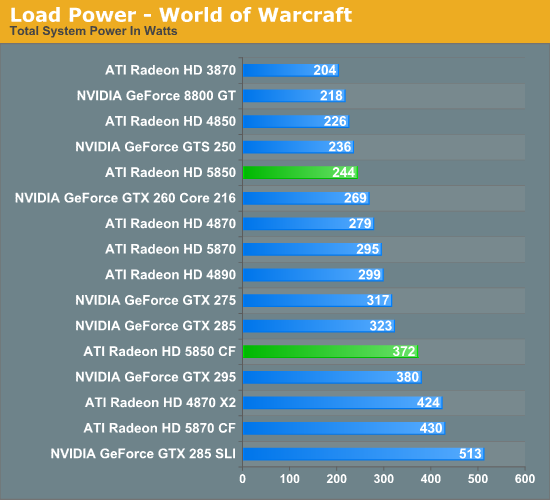
We’ll also take a look at power usage in Warcraft quickly, since it doesn’t trigger throttling in our other AMD cards. Warcraft doesn’t push these cards like OCCT does, so the overall power usage is lower, but the overall situation is virtually the same. The 5850 comes in at 55W less than the 5870, and this time bests the entire GTX lineup by at least 25W. We also see Crossfire do better here; now the 5850 CF can beat even multi-GPU cards like the 4870X2 and the GTX 295.
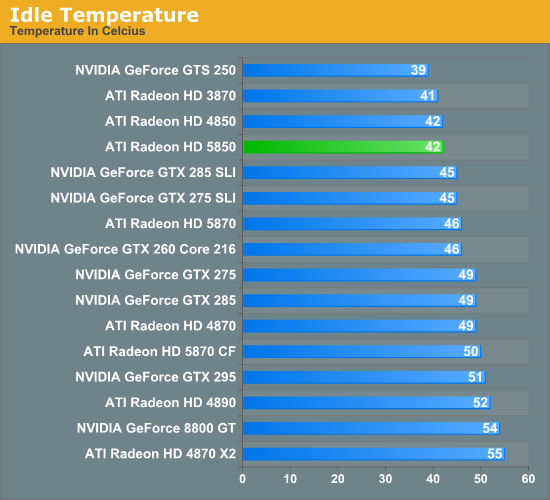
Interestingly enough, in spite of the same idle power as the 5870, the idle temps are not the same. The 5850 comes in at a chilly 42C, bringing it in line with the 4850 and the 3870. Only the GTS 250 can beat it by 3C, and in turn the 5850 beats its closest competitors, the GTX series, by at least 3C.
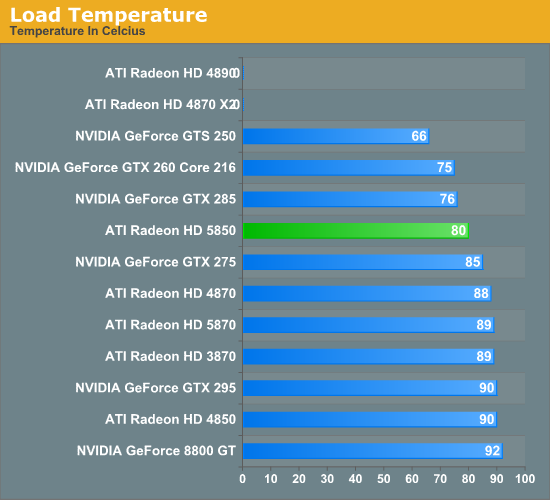
With lower power usage and a similar cooler, the 5850 is capable of keeping cooler than the 5870. While the 5870 approached 90C, the 5850 we’re testing was able to stay at 80C. This makes it the only AMD card we’ve tested that isn’t approaching 90C, which is good news for those of you with limited case ventilation. However it still loses to the GTS 250, and most of the GTX cards. We know NVIDIA is consuming more power, so clearly they have a more effective cooler in use if it’s able to cool their cards that well.
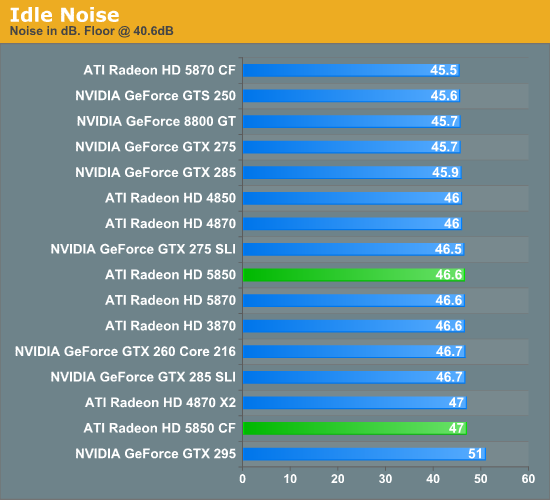
Finally we have noise. At idle virtually everything is the same, the 5850 and the 5870 come in at 46.6dB. To see a significant difference here, we would have to switch to a passively-cooled card.
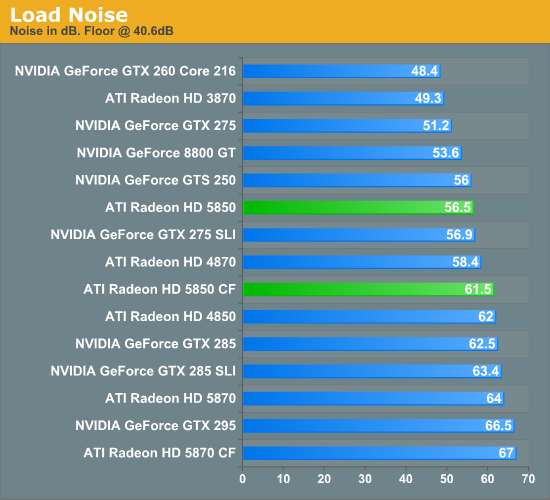
At load, the 5850 is just below the middle of the pack. Thankfully it’s not nearly as loud as the 5870, shaving off 8dB compared to its big brother and brings a Cypress-based card in to more reasonable territory. Adding a second card for Crossfire makes things louder at 61dB, but even that is still 6dB quieter than the 5870 CF.
This also shows us the tradeoffs NVIDIA made in cooling compared to AMD. The GTX 285, which was cooler running, is 6dB louder here as a result. Going by our charts the 5850 is fairly balanced in noise and temperature; it’s doesn’t need to make any trade-offs to achieve one or the other.










95 Comments
View All Comments
Seramics - Thursday, October 1, 2009 - link
HD5800 series is bandwidth limited. The 5850 being less severe than 5870. 5850 has about 77% computing power and about 83% of memory bandwidth of 5870. So normally, 5850 should perform about 77% as fast as 5870 but it wasnt the case here. If you calculate all the benchmarks performance at all resolution, its surprisingly consistent, 5850 is always around 82-85% performance of 5870. Never did it drop to below 80% performance level, let alone coming close to 77% which is where it should be. Different game has different bandwidth requirement and there's fluctuation in percentage improvement from 4800 series to 5800 series. It unstable but 5870 for eg rarely doubles 4870, let alone 4890. So in the end, its not parallelization or scaling problems, nor was it geometry or vertex limitation (possible but less likely), it is indeed the 5800 series being limited in performance due to restricted memory bandwidth. Those of you who has 5800 cards, overclock the memory and check the scaling and you'll see wht i mean.silverblue - Thursday, October 1, 2009 - link
Overclocking the RAM is one idea, adding more RAM is another, however it remains to be seen whether ATI will introduce a wider bus for any higher spec models.The situation is a little different to the 4830 - 4850 comparison whereby the 4830 had slightly lower clocks but only 640 SPs enabled instead of the full 800, however in the end the performance difference wasn't very large so the lack of shaders didn't cripple the 4830 too much.
Jamahl - Thursday, October 1, 2009 - link
I'm not convinced about that, many games run on 3 30" lcd's with no issues.More likely is the games aren't pushing the cards to their maximums, that is why you aren't getting the full effect. We will find out for sure when the 2gb version is released.
Seramics - Thursday, October 1, 2009 - link
If u cant see it thats ur problem, to say games arent pushing it is noobish, 1gb is still plentiful for today's games, memory buffer was nv an issue as long as its 1gb. well in the end u will see faster ram outperforming ur 2gb version. Very amazing to see many people still cant figure out the main reasons of 5870's underperformance.It is still a decent card and offer many features and definitely a better performance to price ratio card than GTX 285. But it is underperforming. Not living up to its nex gen architecture prowess. Unless GT300 screw up, it can easily outperform 5870 when its out. If AMD came out quickly with 5890, they will be wise to significantly bump up the GDDR5 speed as it is unlikely they will go with higher than 256bit design due to their "sweet spot" small die strategy.
Jamahl - Thursday, October 1, 2009 - link
Wait...you really think that you have it figured and ATI didn't realise it? You truly believe that ATI would lower the performance of the card instead of just strapping on a 384 bus?No. Any bandwidth issues only exist in your head. Didn't you say that different games have different bandwith requirements?
Jamahl - Thursday, October 1, 2009 - link
Any ideas what is going on here with that?loverboy - Thursday, October 1, 2009 - link
I would really love to know how these games run with this added xtra.One of my main reasons for upgrading would be to play WOW on three screens (most likely in window mode).
Would it be possible to add this benchmark in the future, with the most obvious config being 3 screens in 2560/1920/1680
yolt - Wednesday, September 30, 2009 - link
I'm looking to pick one of these up relatively quickly. My question is there really a difference in which vendor I purchase from (HIS, Powercolor, Diamond, XFX, etc). I know many offer varying warranties, but if they offer the same clock speeds, what else is there? I guess I'm looking for the most reputable brand since I won't be waiting for too many specific reviews before purchasing one. Any help is appreciated.ThePooBurner - Wednesday, September 30, 2009 - link
Where and under what conditions/server load do you test the frame rate in WoW? I've played for years and with my 4850 i can get 100fps in the game if i am in the right spot when no one else is in the zone. Knowing when and where you do you frame rate tests for WoW would help to put it into context.Ryan Smith - Thursday, October 1, 2009 - link
This is from Anand:"...our test isn't representative of worst case performance - it uses a very, very light server load, unfortunately in my testing I found it nearly impossible to get a repeatable worst case test scenario while testing multiple graphics cards.
I've also found that frame rate on WoW is actually more a function of server load than GPU load, it doesn't have to do with the number of people on the screen, rather the number of people on the server :)
What our test does is simply measures which GPU (or CPU) is going to be best for WoW performance. The overall performance in the game is going to be determined by a number of factors and when it comes to WoW, server load is a huge component."